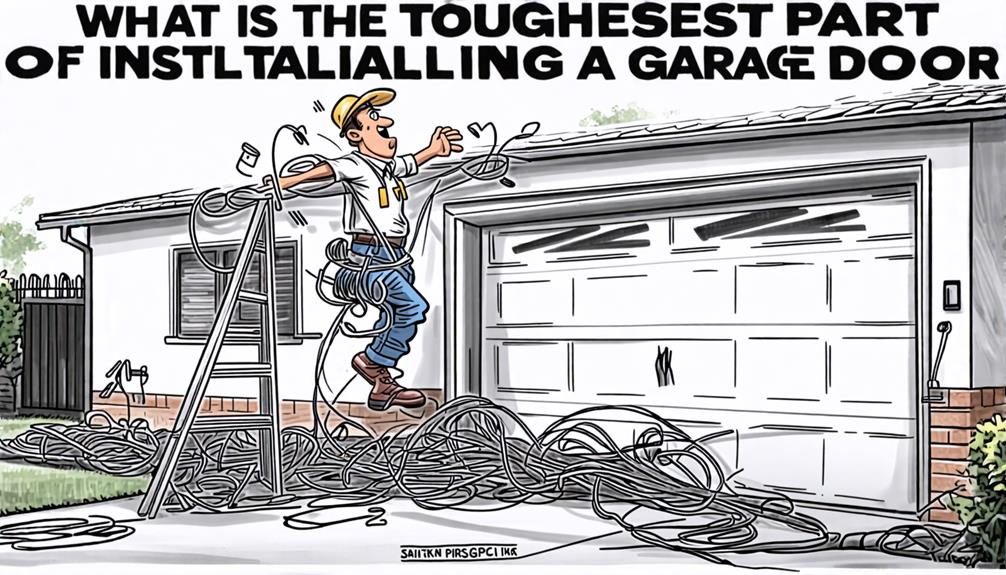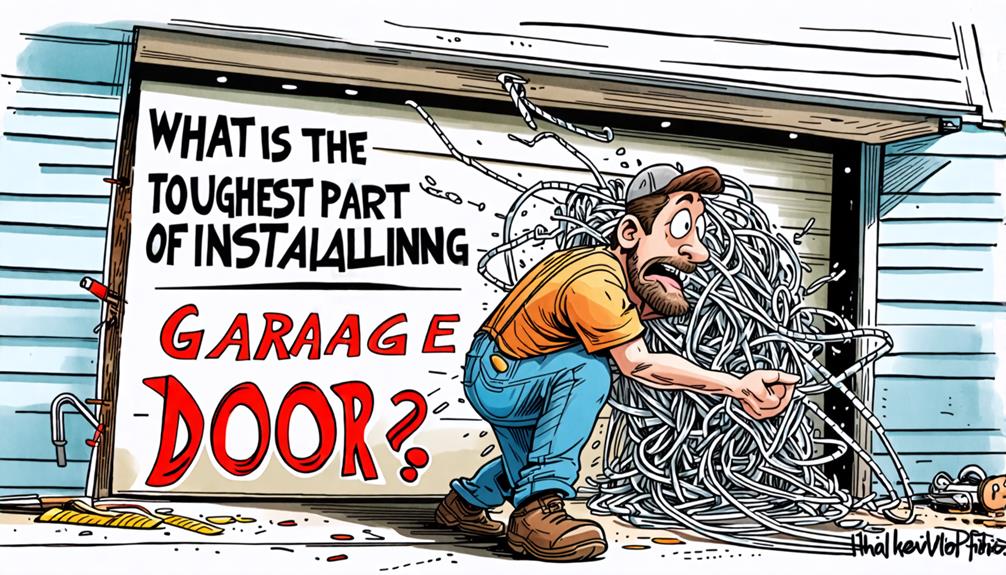
What Is the Toughest Part of Installing a Garage Door?
The most challenging aspect of installing a garage door is safely balancing the tension springs. This task requires specialized tools, meticulous attention to safety precautions, and a thorough understanding of the spring system's mechanics. You'll need to use proper winding bars, wear protective gear, and follow a precise step-by-step process to adjust the tension correctly. Mishandling high-tension springs can lead to severe injuries, making it essential to approach this task with caution and expertise. Proper alignment of tracks, securing brackets, and guaranteeing level positioning are also critical components of the installation process. Mastering these techniques will confirm a safe and efficient garage door operation.
Balancing Tension Springs Safely

When balancing tension springs on your garage door, you'll need to gather the proper tools, including winding bars, a sturdy ladder, and safety equipment. Before you begin, it's paramount to understand the inherent dangers of working with high-tension springs, which can cause serious injury if mishandled.
To safely tension the springs, you'll follow a step-by-step process that involves carefully winding the springs using the winding bars, adjusting the tension incrementally, and testing the door's balance throughout the procedure.
In addition to this, it bears emphasis that regular preventive maintenance can help avoid issues with the tension springs and other components of your garage door. By proactively addressing minor issues, you can help extend the lifespan of your garage door and prevent major problems down the line.
Proper Tools Required
To guarantee safety and efficiency when balancing tension springs, you'll need to have the right tools on hand. The most vital tool is a set of specialized winding bars, which are designed to fit securely into the winding cone holes. These bars should be made of high-quality steel and have a diameter that matches your spring's winding cone. You'll also require a sturdy ladder, preferably a platform-style one, to confirm stability while working at height.
Essential safety equipment includes heavy-duty work gloves, safety glasses, and a hard hat to protect against potential spring failures. A socket wrench set with various sizes is necessary for adjusting bolts and brackets. Don't forget a tape measure for precise spring calculations and a level to ascertain proper alignment. For marking purposes, have a pencil or marker on hand.
Do you have a torque wrench? It's invaluable for achieving the correct tension on bolts. Additionally, pliers, screwdrivers, and a power drill with various bits will prove useful throughout the installation process. Remember, using improvised tools or those not designed for garage door spring adjustment can lead to serious injury or damage. Always prioritize safety by using the correct, well-maintained tools for this challenging task.
Safety Precautions Essential
Safety precautions are paramount when balancing tension springs on garage doors. You'll need to exercise extreme caution, as these springs store an enormous amount of energy and can cause severe injury if mishandled. Before attempting to adjust or replace tension springs, it's critical that you're wearing appropriate personal protective equipment, including safety glasses, gloves, and a hard hat.
Have you secured the door in its fully open position using C-clamps or locking pliers? This step is indispensable to prevent unexpected movement during the adjustment process.
When working with torsion springs, you'll need specialized winding bars to safely add or remove tension. Never attempt to use screwdrivers or other improvised tools, as they can slip and cause serious harm. How familiar are you with the specific type of spring system on your garage door? Understanding the mechanics is essential before proceeding.
If you're unsure about any aspect of the process, it's advisable to consult a professional. Remember, the potential risks associated with improper handling of tension springs far outweigh any cost savings from DIY installation. Always prioritize safety over convenience when dealing with these powerful components.
Step-By-Step Tensioning Process
Typically, the step-by-step tensioning process begins with identifying the type of spring system on your garage door. You'll encounter either torsion springs, mounted above the door, or extension springs, which run parallel to the horizontal tracks. Once identified, guarantee you've gathered the necessary tools, including winding bars, a ladder, and safety equipment.
For torsion springs, you'll start by loosening the set screws on the winding cone. How many quarter-turns should you apply? This depends on the door's weight and size, but generally, you'll need between 20 to 30 full rotations. Insert the winding bars into the cone's holes, applying upward pressure as you turn. After each quarter-turn, does the door lift more easily? If so, you're on the right track.
With extension springs, the process differs slightly. You'll adjust the S-hook or clip that connects the spring to the track hanger. Moving it to a higher hole increases tension, while a lower hole decreases it. Have you checked for equal tension on both sides? This equilibrium is vital for proper door operation. Remember, if you're unsure at any point, don't hesitate to consult a professional. Your safety is paramount in this intricate process.
Benefits

Installing a new garage door offers numerous advantages that extend beyond mere functionality. With the right garage door installation, your home's aesthetic appeal can be markedly improved, adding to its market value.
You'll boost your home's value while simultaneously improving its energy efficiency, as modern garage doors provide better insulation against outdoor temperatures. Additionally, you'll enhance your property's security with advanced locking mechanisms and access control features, allowing you to monitor and operate your garage door remotely.
Enhanced Home Value
When it comes to boosting your property's worth, a new garage door can be a game-changer. It's not just about aesthetics; a well-installed, high-quality garage door can significantly increase your home's resale value. Real estate experts often cite curb appeal as an essential factor in determining a property's market value, and your garage door plays a substantial role in this assessment.
Have you considered the impact of your garage door on potential buyers? A modern, secure, and energy-efficient garage door can be a major selling point. It demonstrates that you've invested in maintaining and upgrading your property, which can instill confidence in prospective purchasers. Additionally, an updated garage door can enhance your home's overall energy efficiency, potentially leading to lower utility costs—a feature that's increasingly attractive in today's market.
When selecting a new garage door, consider materials like steel, wood, or composite that offer durability and visual appeal. Insulated options can provide additional energy savings and noise reduction. Remember, the ROI (Return on Investment) for a garage door replacement is consistently high, often exceeding 90% according to industry reports. This makes it one of the most cost-effective home improvement projects you can undertake.
Improved Energy Efficiency
Energy savings are a vital benefit of installing a modern garage door. When you upgrade to an insulated garage door, you're not just improving the aesthetics of your home; you're also enhancing its thermal efficiency. These doors typically feature polyurethane or polystyrene foam insulation, which creates a barrier against heat transfer.
How does this impact your home's energy consumption? By maintaining a more consistent temperature in your garage, you reduce the workload on your HVAC system, particularly if your garage is attached to your house.
The improved insulation can also help regulate humidity levels, preventing moisture-related issues that can affect items stored in your garage. Have you considered the R-value of your garage door? This measure of thermal resistance is imperative; the higher the R-value, the better the insulation. Modern insulated garage doors can offer R-values ranging from R-6 to R-18, vastly outperforming older, non-insulated models.
Additionally, weather stripping and bottom seals on new doors further enhance their energy-saving capabilities by eliminating drafts and air leaks. Ultimately, investing in an energy-efficient garage door can lead to lower utility bills and a more comfortable living space.
Increased Security Measures
Today's garage doors offer a significant upgrade in home security. When installing a new garage door, you'll find several features designed to protect your property and loved ones. Modern doors often come equipped with reinforced panels and frames, making them more resistant to forced entry.
You'll also encounter advanced locking mechanisms, such as multi-point locking systems or smart locks that can be controlled remotely via your smartphone. Many new garage doors incorporate tamper-resistant hardware, including concealed hinges and tracks that prevent intruders from easily manipulating the door's components.
Have you considered the benefits of integrated alarm systems? These can be seamlessly connected to your home's security network, alerting you to any unauthorized access attempts. Additionally, you'll find options for impact-resistant windows or solid panels that eliminate potential entry points.
Don't overlook the importance of proper installation when it comes to security. Ascertain that the door is correctly aligned and that all safety features, such as auto-reverse mechanisms and photo-eye sensors, are functioning properly. By investing in these enhanced security measures, you're not only protecting your garage but also fortifying a vulnerable entry point to your home.
Convenient Access Control
Modern garage doors frequently offer convenient access control features that revolutionize how you enter and exit your property. These systems typically include remote controls, keypad entry, and smartphone integration, allowing you to operate your garage door from various devices. Have you ever wondered how these technologies work together seamlessly?
Remote controls use radio frequency signals to communicate with your garage door opener, enabling you to open or close the door from a distance. Keypad entry systems, mounted outside your garage, provide a secure way to access your home without carrying keys or remotes. You'll simply enter a personalized code to trigger the door.
Smartphone integration takes convenience a step further, allowing you to control your garage door from anywhere with an internet connection. This feature is particularly useful when you need to grant access to service providers or family members while you're away.
Many modern systems also incorporate additional safety features, such as automatic reversal if an obstruction is detected, and timed closing to guarantee your garage isn't accidentally left open. How might these advanced access control options benefit your daily routine and enhance your home's overall security?
Proper Alignment of Tracks

When installing a garage door, proper alignment of tracks is essential for smooth operation and longevity. You'll need to employ precise measurement techniques to guarantee the tracks are perfectly parallel and level. Once you've positioned the tracks correctly, securely fasten the track brackets to the wall and ceiling, ensuring they can withstand the door's weight and movement.
| Alignment Step | Key Considerations | Tools Required |
|---|---|---|
| Measuring | Accuracy, symmetry | Tape measure, laser level |
| Positioning | Plumb, level, square | Level, plumb bob |
| Securing | Sturdy anchoring | Drill, wrenches, lag bolts |
Precise Measurement Techniques
Nailing down precise measurements is critical for proper track alignment when installing a garage door. You'll need to measure the width of the door opening at three points: top, middle, and bottom. Why? Because walls aren't always perfectly straight, and these measurements will help you identify any discrepancies.
Next, measure the height of the opening on both sides, guaranteeing you have enough headroom for the door to operate smoothly.
When it comes to track alignment, exactness is key. You'll want to use a laser level or a long spirit level to make certain the vertical tracks are perfectly plumb. How do you achieve this? Start by measuring the distance between the tracks at the bottom, which should be the door width plus 1 inch. Then, check that this distance remains consistent as you move up the tracks.
Are the horizontal tracks level? Use your level to confirm, and don't forget to measure the slope – it should rise about 1/8 inch per foot of track. Remember, even small deviations can lead to significant problems down the line. By employing these precise measurement techniques, you're setting the foundation for a smoothly operating garage door.
Leveling and Positioning
How essential is proper leveling and positioning when aligning garage door tracks? It's absolutely indispensable for ensuring seamless operation and longevity of your garage door system.
When installing tracks, you'll need to achieve perfect vertical alignment and maintain consistent spacing between them. Start by using a plumb bob or laser level to establish true vertical lines for track placement. You'll want to ensure the tracks are parallel to each other and perpendicular to the garage floor.
As you secure the vertical tracks, use a level to check their alignment at multiple points. Are they perfectly straight? Any deviation can cause binding or excessive wear on rollers.
Next, focus on the horizontal tracks. These must be level and sloped slightly towards the back of the garage. Use a carpenter's level and adjust the hanging brackets accordingly. Remember, even a small misalignment can lead to significant problems over time.
Have you checked the distance between tracks? It should be consistent and match the width of your door panels. Proper spacing prevents the door from shifting laterally during operation.
Securing Track Brackets
Why is securing track brackets imperative for proper garage door alignment? The precision with which you install these indispensable components can make the difference between a smoothly operating door and one that's prone to malfunctions.
As you begin this step, you'll need to confirm that the vertical tracks are plumb and the horizontal tracks are level, with both sets parallel to each other.
You'll start by attaching the flag brackets, which connect the vertical tracks to the jamb. These must be secured firmly, as they bear significant weight and stress. Next, you'll install the horizontal track brackets, which support the tracks along the ceiling. It's critical to space these brackets evenly and anchor them securely to the framing. Are you using the manufacturer-recommended lag screws and washers? This hardware is pivotal for maintaining the integrity of your installation.
As you work, continually check the alignment of your tracks. Even a slight misalignment can cause the door to bind, creating unnecessary wear on the components. How can you verify proper alignment? Use a level and measure diagonally between tracks to ensure they're square and parallel.
Frequently Asked Questions
How Long Does a Typical Garage Door Installation Take?
You'll typically need 4-6 hours for a standard garage door installation. It'll vary based on the door's complexity and your experience level. Professional installers might complete it faster, while DIY efforts could take longer.
Can I Install a Garage Door by Myself?
You can install a garage door yourself, but it's challenging and potentially dangerous. You'll need specialized tools, strength, and technical know-how. It's often safer and more efficient to hire professionals for this complex task.
What Tools Are Required for Garage Door Installation?
You'll need a variety of tools for garage door installation, including a drill, socket set, level, tape measure, and wrenches. Don't forget safety gear like gloves and goggles. You'll also require a ladder and possibly a helper.
How Often Should Garage Door Maintenance Be Performed?
You should perform basic garage door maintenance every 3-6 months. Inspect and lubricate moving parts, tighten hardware, and check the balance. Don't forget to test safety features annually. Regular upkeep guarantees smooth operation and extends your door's lifespan.
Are Smart Garage Door Openers Compatible With All Door Types?
You'll find that most smart garage door openers are compatible with various door types. However, it's best to check the specifications of your chosen opener. Some may require adapters or additional hardware for certain door styles or sizes.





